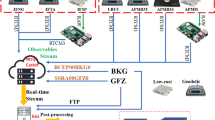Abstract
Navigation space missions are mainly timing missions. They use extremely accurate atomic clocks embarked on their satellites and as part of their ground infrastructure. Clocks in motion with respect to each other and moving in different gravitational potentials are the perfect mix to experiment relativistic effects. Despite the appearances, these effects are not negligible. This paper describes how these effects are being tackled in the European GNSS Galileo.
Similar content being viewed by others
References
N. Asbhy, J. Spilker, ”Introduction to Relativistic Effects in the Global Positioning System”, Chapter 18 in Global Positioning Systems: Theory and Applications, Vol.I, eds., B. W. Parkinson and J. J. Spilker, Jr., Progress in Astronautical and Aeronautics,Vol 163, AIAA, Inc., 370 L”Enfant Promenade, SW, Washington, DC 20024–2518, 1996
N. Ashby, ”Relativistic Effects in the Global Positioning System”, 2006, https://www.aapt.org/doorway/TGRU/ articles/Ashbyarticle.pdf
Galileo OS Signal in Space ICD Issue 1, http://ec.europa.eu/enterprise/policies/satnav/galileo/ open-service/index_en.htm
S. Weinberg, Gravitation and Cosmology: Principles and Applications of the General Theory of Relativity, J. Wiley and Sons, 1972
P. Waller et al., ”Update on the In-orbit Performances of GIOVE Clocks”, EFTF-FCS, Besancon, France, 20–24 April 2009
R. Zanello et al., ”Implementation and On-Site activities of Galileo Precise Timing Facility”, Proceedings of EFTF, Noordwijk, The Netherlands, 2010
Communication with Dr. Andreas Bauch and Dr. Patrizia Tavella, 11 December 2013
Interface Specification, IS-GPS-200, Revision E, 8 June 2010
GLONASS Interface Control Document, v5.1, 2008
E. Breeuwer et al., ”Galileo Works! Results of the Galileo In-Orbit Validation Test Campaign”, Inside GNSS, March/April 2014.
P. Waller et al., ”The In-Orbit Performances of GIOVE Clocks”, IEEE Transactions on Ultrasonics, Ferroelectrics, and Frequency Control, vol. 57, no. 3, March 2010, pp. 738–745.
Recommendation ITU-R TF.2018, Relativistic time transfer in the vicinity of Earth and in the solar system, 08/2012
R. Nelson and T. Ely, Relativistic Transformations for Time Synchronisation and Dissemination in The Solar System, Proceedings of the 38th PTTI Meeting, pp. 305–317, 2006
I. Shapiro, Fourth Test of General Relativity, Physical Review Letters, vol. 13, number 26, pp. 789–791, 1964
Recommendation ITU-R TF.1153-2, The operational use of two-way satellite time and frequency transfer employing PN codes (Question ITU-R 201/7), 2003
P. Defraigne et al., Use of Geodetic Receivers for TAI, Proceedings of the 33rd PTTI Meeting, pp. 341–348, 2001
Author information
Authors and Affiliations
Rights and permissions
About this article
Cite this article
Mudrak, A., De Simone, P. & Lisi, M. Relativistic Corrections in the European GNSS Galileo. Aerotec. Missili Spaz. 94, 139–144 (2015). https://doi.org/10.1007/BF03404697
Published:
Issue Date:
DOI: https://doi.org/10.1007/BF03404697




